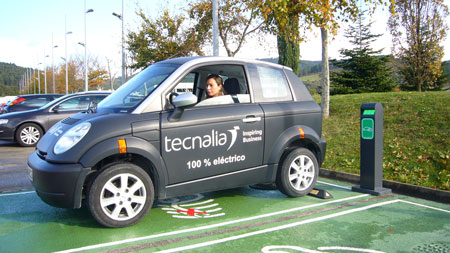| Dec 13, 2012 |
A major step in wireless recharging of electric vehicles
|
|
(Nanowerk News) TECNALIA, largest private Research, Development and Innovation group in Spain, has developed a system for wireless rechargingof electric car batteries, just like the batteries of toothbrushes are being recharged.
|
|
The system has an element located in the ground, transmitting electricity to another receptor element which is fitted to the vehicle. When the emitter detects that the car is above it, it connects wirelessly and starts to transfer energy. It is similar to the way in which a wireless toothbrush is recharged; just bringing the apparatus close to a base without the need for an actual electrical contact.
|
 |
| Wirelessly recharging an electric car
|
|
The systems developed to date for recharging a vehicle are conductive, energy being conducted through an electric lead. The novelty of this system is that the recharging is inductive, i.e. the energy is transmitted through an electromagnetic field. In these cases, the recharging time is similar to conductive ones and they have an efficiency of 93% of the energy.
|
|
Apart from the convenience that the system developed by TECNALIA provides for the electric vehicle user, the advantages for the car itself should be considered.
|
|
First and foremost, there are the cost savings. The enhanced performance of the electric motor compared to the traditional combustion engine means that the cost per kilometre is between 4 and 6 times less than the petrol-driven vehicle. Thus, if a petrol-driven vehicle goes 20,000 kilometres in one year, about 1,800 euros is spent in fuel, while the electric car costs 360 euros.
|
|
Secondly is the reduction in environmental impact. This is because, on the one hand, these vehicles have zero emissions of CO2 and, on the other, the electricity that they use and that is generated by the country’s electric grid produces 5 kilogrammes of CO2 for every 100 kilometres, compared to 20 kilogrammes per 100 kilometres from a conventional car. That is, contaminant emissions are reduced by a quarter.
|
|
Finally, it has to be taken into account the total reduction of acoustic contamination produced by conventional vehicles as electric cars do not emit noise.
|

